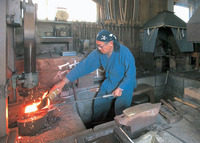

Total:131items
- Pottery & Porcelain (18)
- Lacquerware (4)
- Glasswork (2)
- Wood & Bamboo Work (19)
- Leather Work (1)
- Papermaking (13)
- Textile (20)
- Dyeing products (5)
- Masonry (1)
- Metal Work (11)
- Satsuma Suzuki: Satsuma Tinware
- Tosa Uchihamono: Tosa Blade
- Kaga Zougan: Kaga Inlay
- Akita Ginsen Zaiku: Akita Filigree
- Token: Japanese Sword
- Banshu-gama : Banshu Sickle
- Echigo-Sanjo Uchi Hamono: Echigo-Sanjo Blade
- Osaka Naniwa Suzuki: Pewter/Tin Ware
- Nakaniida-Uchihamono: Nakaniida Traditional Blade
- Higo-Tsuba
- Nokaji Hamono: Nokaji Blades
- Stationery (4)
- Livingware (3)
- Accessory (4)
- Toys & Entertainment (14)
- Interior (2)
- Other crafts (10)

 |
Main Production Site:Kumamoto |
 《Characteristics》
《Characteristics》There are two swordsmith groups which represents Higo (present day Kumamoto Pref, Southern Japan): the Enju school which is famous for Kikuchi Senbon Yari (spears invented by Kikuchi clan in 14c for collective combats), and Doutanuki school which created glorious and sharp standing swords of Kumamoto Castle by earning the trust of KATO Kiyomasa (the feudal lord in Higo Domain reigned from the Azuchi-Momoyama period to the early Edo period, 16-17c).
The blade of Higo swords are wider and thicker compared to other regional swords, and optimized for battles. The style of the sword is dynamic and simple without much decoration, while enhancing robustness and strength.
Until today Higo swords are created in Kumamoto, by craftsman with the traditional iron making method called "Tatara", which obtains iron of high purity by reducing iron sand in relatively low heat of charcoal.
[Kumamoto designated traditional crafts]
Information provided by: Matsunaga Nihon Touken Tanrenjo
Pictures provided by: Arao City
Tlanslated by: Junna Kawaguchi
| Materials | Tama-hagane (Japanese steel made from iron sand), Kowatetsu (iron suitable for smithing), etc |
|---|---|
| Crafting Processes | Put tama-hagane into hodo (oven using pine charcoal for forging) and turn it to 1400 degrees. Repeat hitting, stretching and folding tama-hagane for a few dozen times to reshape it, of which the method is called "Orikaeshi Tanren".
After two weeks, one Japanese sword is finally created. Every process is dangerous and craftsmen often get hurt and a burn, therefore they need extreme skills and concentration to forge swords. |
| History | A swordsmith called Kunimura who is a grandson of Rai Kuniyuki at Yamashiro-no-kuni, present day southern part of Kyoto, moved to Kumamoto and started to create swords at the request of Kikuchi clan, and named the swordsmith group Enju school .
In the early years of the Northern and Southern Courts period (1334-1392, the period during which occurred the conflict between the Southern Imperial Court in Nara and the Northern Imperial Court in Kyoto), spears called Kikuchi Senbon Yari were created by Enju school based on the idea of Kikuchi Takemitsu (a Southern Court general from Kumamoto). Although there are about 30 masters from Enju school since the middle of the Kamakura period (12-13c) until the Northern and Southern Courts period, Enju school declined after the fall of Kikuchi family. However, it was later rebuilt and a couple of offshoots were split from Enju school, such as Ishinuki school and Doutanuki school. There are still swordsmiths in Arao and Yashiro region to collect sand iron in the Arao coast and create Japanese swords by traditional Tatara iron making method. |
◆Exhibition / Showcase
Matsunaga Nihon Touken Tanrenjo
1907-80, Kawasumi, Arao City, Kumamoto Prefecture
864-0031
TEL: +81(0)968-68-2250 / FAX : +81(0)968-68-1898 (Japanese only)
Visit: 15 minutes from Arao Station by car / 25 minutes from Nankan Interchange by car
◆Event Information
Matsunaga Nihon Touken Tanrenjo
You can visit and see the process of creating Japanese swords.
Price: 1000 yen
More information available at: +81 968-68-2250 (Japanese only)
* Reservation one week prior to your visit is necessary
Assistance needed? For inquiries in English:
JTCO Contact Form
Your inquiries will be forwarded by JTCO in Japanese to the organization you wish to contact.
*Please write the name of craft you wish to ask about.



